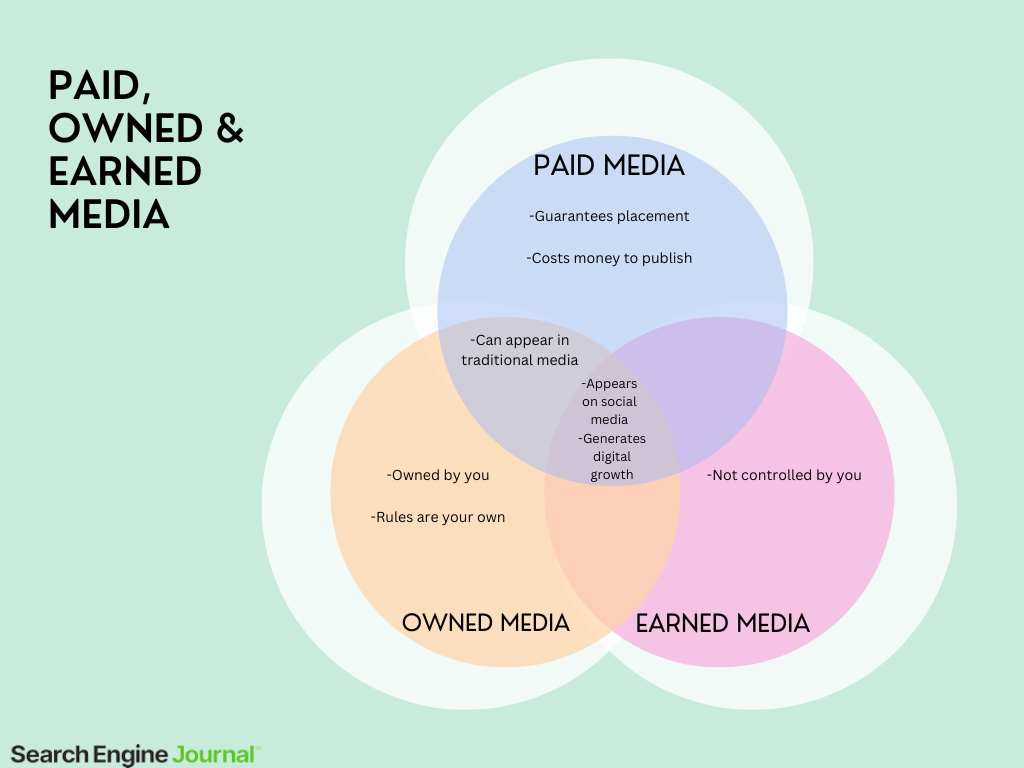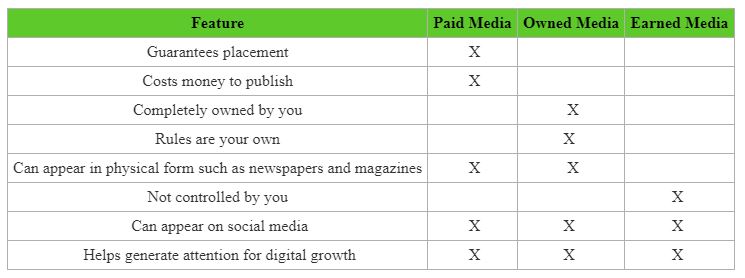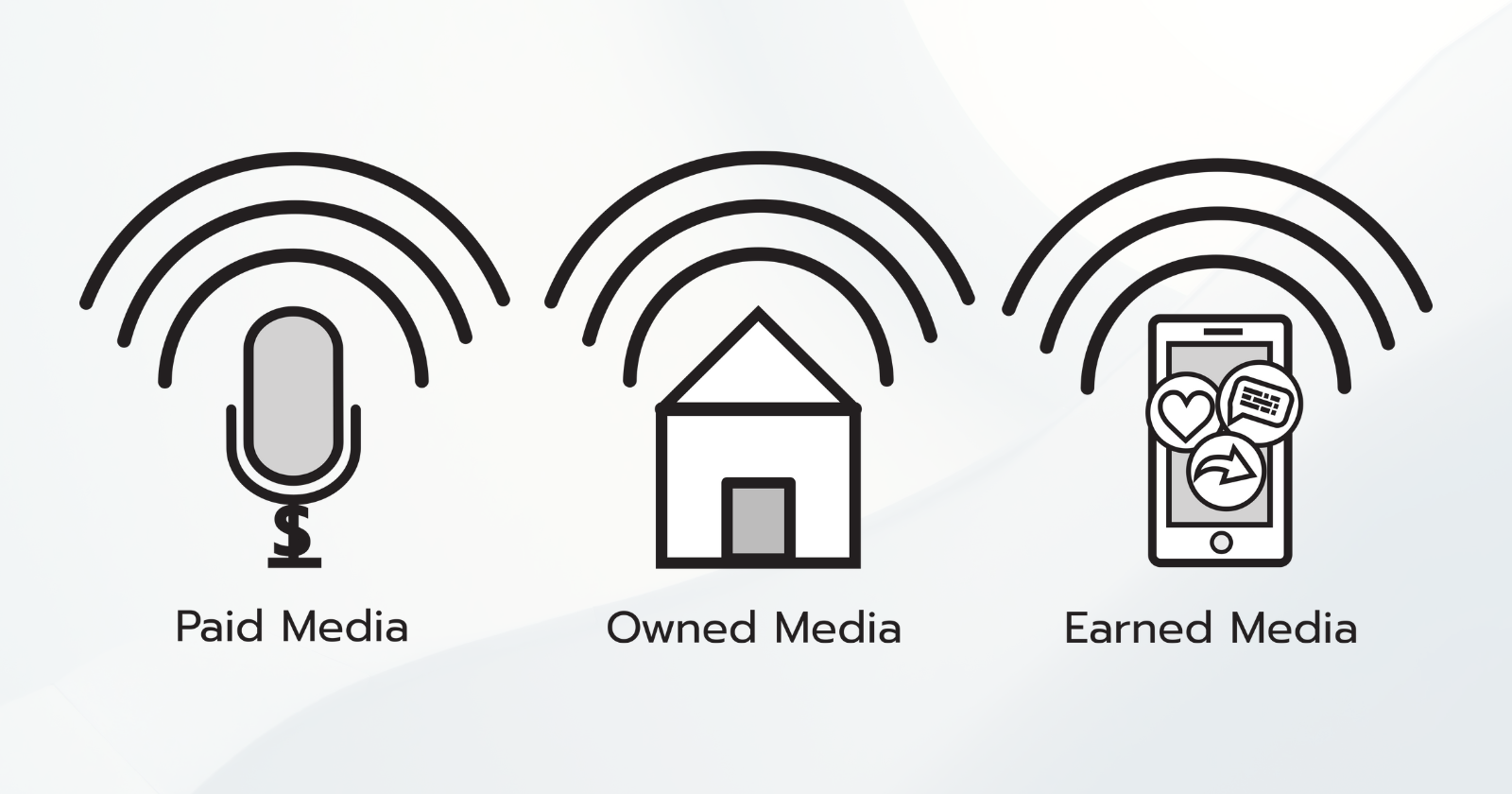The internet is like the universe: There are so many things whizzing around all the time and in just about every place that it can be hard to know exactly what’s what.
Just like the universe, we categorize phenomena to understand them better. Media can appear in various types, forms, and channels.
But there are three categories critical for marketers to understand. They are:
- Paid media.
- Owned media.
- Earned media.
The task ahead is to understand what each type of media means and, more importantly, how to employ each separately and together.
What Is Paid Media?
The key to wielding anything skillfully is defining and understanding it. To that end: What is paid media?
As it sounds, paid media is any content you pay to have placed on an advertising platform.
Paid media includes PPC ads on Google, ads on Facebook, and display ads that follow you on websites that sell ad space.
You could also go back to physical paid media and identify newspapers, magazines, and billboards as platforms that sell ad space.
Paid media is one of the primary ways that businesses advertise today.
Ads placed on Google, Facebook, Instagram, Twitter, and other places generate billions in revenue for those platforms annually.
Your ROI for the paid media you place will depend on so much, from the copy you write to the imagery you use, but rest assured; you can win traffic and conversions from your paid media efforts if you approach them in all the right ways.
 Image created by author, February 2023
Image created by author, February 2023What Is Owned Media?
Conversely, owned media is any content you entirely own and can publish yourself without additional costs or effort.
Owned media can have any purpose you give to it. Like paid media, your goals for your owned media could be anything, from traffic and clicks to conversions.
The point is that owned media is free to you, and you can disseminate any information you want on your owned platforms.
Owned Media Examples
The most common types of owned media include websites that you own, the organic posts you make on your social media channels, and the email marketing campaigns you run.
These platforms are owned media because you have complete control over them and can publish anything you want without having to pay someone else or rely on any other party to create and distribute it.
What Is Earned Media?
Earned media is probably the one type of content on this list that some readers haven’t heard stated as such, but I’ll bet you have seen earned media before.
Earned media consists of all the content about you or your brand on the internet that doesn’t come from you. It’s nothing that you even touch.
Earned media comprises all the mentions, links, and other discussions in which people on other websites or social media platforms talk about you.
How do you generate that kind of positive word of mouth? It all comes from the work you do on the paid and owned media end of things.
You won’t earn anyone’s free attention if no one knows who you are, and for that, you have to put work in at the beginning.
If you’re generating serious value through your website content, social media posts, and paid media advertising, you’re positioning yourself well to earn that free media.
Earned Media Examples
Because earned media is free attention, and there’s nothing you can do directly to acquire that spotlight, understanding what earned media actually looks like can still be a bit tricky.
Keep that in mind as you peruse this collection of earned media examples that the best brands receive completely on the strength of what they offer the public:
- Social media mentions.
- Coverage in any form of news media, including interviews and feature stories.
- Product or service reviews from influencers, roundup posts, or review websites.
- Backlinks from other websites.
- Real estate on search engine results pages (SERPs).
All of these things, even search engine rankings, are technically earned.
Even though you took direct action to make those outcomes more likely, you did not go out and pay to rank in position one on Google.
That happened because you leveraged your owned media on your website, but the result you produced from that effort is surely earned media and nothing else.
You are now receiving “free” attention on a Google SERP for all to see.
How To Integrate Paid, Owned, And Earned Media
As you can imagine, at this point, it pays to combine all these forms of media together in your overall digital marketing strategy.
Paid, owned, and earned media should all be in your business’s digital growth.
The obstacle you now must overcome is: How do you appropriately combine them all?
The simple answer (simple in theory, not necessarily in practice) is that you should coordinate your digital efforts across all your media channels.
Consistency is going to win the day here.
You’ve probably heard this idea before in relation to branding: When you’re developing a business brand, you should keep it the same everywhere you are, from your social platforms to your website to billboards and TV commercials.
The same concept applies to your content.
If you publish an incredible infographic on your website (owned media), post it simultaneously on all your social media channels (owned media).
If website traffic is what you’re after, you can buy digital ad space on the Google Display Network or Facebook (paid media) to attract audiences to your site to see the full infographic.
Ideally, if the content is new and useful enough, it will start to earn backlinks (earned media) and maybe even inclusion in some roundup posts (earned media) about the best infographics in your industry in a certain period.
Again, none of this is to say that combining all three media forms is easy. It surely takes work, persistence, and a whole lot of patience to get it right.
But integrating paid, owned, and earned media is absolutely your best bet for getting your content and business brand out there in the digital space in a way that people will notice.
 Image created by author, February 2023
Image created by author, February 2023Which Is Best: Paid, Owned, Or Earned Media?
Finally, I want to address a remaining question that some of you may have at this point: Of paid, owned, and earned media, which one is the best for earning digital attention?
Frustrating though it may be, the answer is that – it depends!
No one type of digital media will be best for your business across the board, and here’s why: Each has its pros and cons.
Take paid media, for example. You can make up a killer ad for Google or Instagram and say that’s how you’re going to get all your attention, but remember that you have to pay for that and factor your expenses into your earnings.
Sure, you get guaranteed placement on the platform, but it comes at the cost of real money and still no promise of reward.
With owned media, you have sort of the opposite pros and cons. You own the media platforms. It’s your website and your social media channels.
You don’t have to pay to publish content there, and you control everything about what you publish.
But remember that if you own this media, you also own the effort to disseminate it to your digital audiences. You get no Google or Meta ad platforms to place your stuff. It’s all about the organic traffic you can drum up yourself.
Then there’s earned media, which you have no control over whatsoever.
The thing is, just about everyone who maintains an online presence is doing so to earn a living, promote a cause, or gain attention in some way.
Everyone wants earned media, and it can easily be combined with anything else that you’re doing to form a strong, healthy digital marketing approach.
Which form of media is best? It’s up to you to decide.
You know what you can handle, from the actual costs of paid media to the organic efforts you’d have to put in for owned media. Earned media can come as a result of either of those.
The best type of media for your business is the one you can handle with true finesse.
More Resources:
Featured Image: Siri Siripan/Shutterstock
